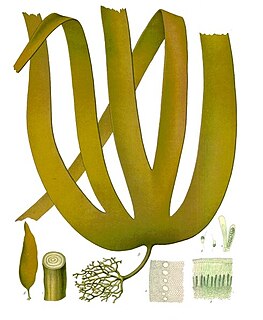
Laminariaceae is a family of brown algal seaweeds, many genera of which are popularly called "kelp". The table indicates the genera within this family. The family includes the largest known seaweeds: Nereocystis and Macrocystis.

The Fucales (fucoids) are an order in the brown algae. The list of families in the Fucales, as well as additional taxonomic information on algae, is publicly accessible at Algaebase.

AlgaeBase is a global species database of information on all groups of algae, as well as one group of flowering plants, the sea-grasses.
Ascoseira is a monotypic genus of seaweed in the brown algae. The single and type species, Ascoseira mirabilis Skottsberg, is a large parenchymatous macroalgae, and is endemic to the Antarctic Ocean. Ascoseira is assigned to its own order. The alga grows in subtidal waters at depths of from 3 to 15 meters.

Dictyotales is a large order in the brown algae. Members of this order generally prefer warmer waters than other brown algae. One genus in this order is calcareous, Padina, the only calcareous member of this phylum.

Ectocarpales is a very large order in the brown algae. The order includes families with pseudoparenchymatous (Splachnidiaceae) or true parenchymatous (Scytosiphonaceae) tissue. Pseudoparenchymatous refers to a filamentous alga with cells packed very close together to give an appearance of parenchymatous tissue, the latter being composed of cells which can truly divide in three dimensions, unusual among the algae. Filamentous algae are composed of cells that divide along a single plane, allowing only elongation to form filaments of one or more rows of cells. Algae that can divide in two planes can form sheet-like thalli or bodies. Cells that can divide in a third plane potentially allow for the organism to develop a more complex body plan, and diversification of body plans into an erect thallus of some sort and a holdfast for attaching the upright portion to the substrate.

Alaria is a genus of brown alga (Phaeophyceae) comprising approximately 17 species. Members of the genus are dried and eaten as a food in Western Europe, China, Korea, Japan, and South America. Distribution of the genus is a marker for climate change, as it relates to oceanic temperatures.

Durvillaea antarctica, also known as cochayuyo and rimurapa, is a large, robust species of southern bull kelp found on the coasts of Chile, southern New Zealand, and Macquarie Island. D. antarctica, an alga, does not have air bladders, but floats due to a unique honeycomb structure within the alga's blades, which also helps the kelp avoid being damaged by the strong waves.
Onslowiaceae is the only family in order Onslowiales in the brown algae. The family contains only the genera Onslowia and Verosphacela.
Nemoderma is the only genus in the family Nemodermataceae and order Nemodermatales of the brown algae. The genus contains only a single species, Nemoderma tingitanum.

Ishige is a genus of brown algae occurring in the warm temperate regions of the western Pacific Ocean. It is the only genus in the family Ishigeaceae.
Tilopteridales is an order of brown algae with isomorphic alternation of generations.
Scytothamnales is an order of brown algae.

Choristocarpaceae is a family in the order Discosporangiales of the brown algae. The family contains a single genus, Choristocarpus.

Ralfsiales is an order of crustose brown algae containing two families.

Dictyotaceae is large family of brown algae. Members of this order generally prefer warmer waters than other brown algae. One genus in this order is calcareous, Padina, the only calcareous member of this class. Lobophora variegata often presents a beautiful blue iridescence due to microscopic bacteria which live on the surface of the blades [interesting observation but needs citation - please substantiate, clearly there are bacteria on the blades but are they the source of the iridescence?]. A number of genera are known as forkweed (e.g. Dictyota, Glosophora, Dilophus, Dictyopteris, Pachydictyon and Lobospira.

Himanthalia is a genus of brown algae. It is the only genus in the family Himanthaliaceae in the order Fucales. It includes two species: Himanthalia durvillei and Himanthalia elongata.

Desmarestiaceae is a family of brown algae, one of two families in the order Desmarestiales. The family gets its name from the genus Desmarestia, which is named after the French zoologist Anselme Gaëtan Desmarest (1784-1838).

Scytosiphonaceae is a family of brown algae in the order Ectocarpales.

Sporochnus elsieae is a marine brown algal species in the family Sporochnaceae, endemic to New Zealand. It was first described in 1960 by Victor Lindauer who gave it the specific epithet, elsieae, in honour of his wife, Elsie.














